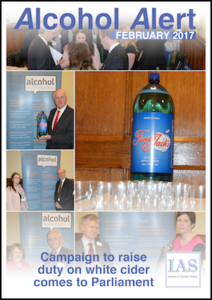In this month’s alert
Editorial – February 2017
Welcome to the February 2017 edition of Alcohol Alert, the Institute of Alcohol Studies newsletter, covering the latest updates on UK alcohol policy matters.
In this month’s issue, A grieving mother leads calls for an increase in duty on cheap, high-strength alcohol at a parliamentary event held ahead of the upcoming Spring Budget. Other articles include: New IAS report shows the industry case for lower alcohol taxes is overstated; and official data finds no progress in reducing both drink-drive and alcohol-related deaths overall.
Please click on the article titles to read them. We hope you enjoy this edition.
TOP STORY: Two-thirds of public support tax rises on cheap cider
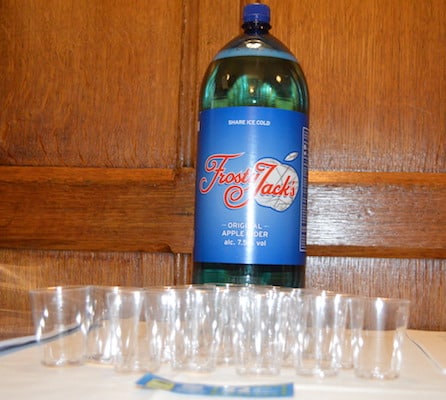 Calls grow for alcohol duty to target cheap, high-strength drink
Calls grow for alcohol duty to target cheap, high-strength drink
A grieving mother led calls for an increase in duty on cheap, high-strength alcohol at a parliamentary event held ahead of the upcoming Spring Budget.
Hosted by the Alcohol Health Alliance and Thames Reach, a London based charity working with those suffering from homelessness, the event attracted politicians from the major parties, including Conservative MPs David Burrowes and Fiona Bruce, who both spoke of the need to deal with the impact of white cider on the health and wellbeing of rough sleepers at an event held in the Houses of Parliament.
The event also involved a speech from the mother of a teenage girl who died in her sleep after consuming white cider at a New Year’s Eve party three years ago. Joanne Good’s daughter Megan had drunk half a three-litre bottle of 7.5% ABV Frosty Jack’s over a period of four or five hours.
“I never knew that level of alcohol per volume was available,” Joanne told The Mirror.
“Teenagers and young adults need to know how dangerous it [white cider] can be. You see them buying it or looking for it in corner shops. It has been going on for generations,” she added.
There is evidence that the UK public share Joanne’s concerns over cheap, high strength cider. Recent opinion polling conducted by the Alcohol Health Alliance UK (AHA) found that 66% of respondents would back tax increases on products such as Frosty Jack’s and White Ace.
Strong cider attracts the lowest duty per unit of any alcohol product, hence the typically 7.5% ABV, three-litre bottles – which contain the same amount of alcohol as 22 shots of vodka – can be bought in off-trade premises for as little as £3.49, or just 16p per unit.
Due to their low price and high-strength, street drinkers and children account for nearly all sales of these ciders. Many people in treatment for alcohol problems also consume these products, having “traded down” to cider as their drinking became heavier. An increase of the kind proposed by the AHA would target precisely the drinks affecting heavy and vulnerable consumers, while leaving the other 80% of cider products in the alcohol market untouched.
Commenting on the issue, Dr Peter Rice, chair of Scottish Health Action on Alcohol Problems and a psychiatrist who worked in an NHS Alcohol Problems service in Tayside from 1990 until 2013 said:
“Colleagues and I became aware of the damage being done by high-strength ciders in the mid-1990s, when 2 and 3-litre bottles of these ciders, known to drinkers as “submarines” came on the market, and they began to replace the strong lagers which had dominated consumption up until then.
“The harmful impact of cheap, high-strength ciders is now widely recognised by those working in health and care services and in the wider population.
“Cider has received preferential treatment in the duty system, and this has allowed products to develop which cause a great deal of harm to the health of UK citizens. It is time to tackle the issue of cheap cider, and indeed all cheap alcohol, through targeted increases in tax and minimum unit pricing, to minimise the harm done in the future.”
Alongside duty increases, the AHA has urged the Chancellor to implement minimum unit pricing for alcohol, and to reinstate the alcohol duty escalator. Introduced in 2008, the duty escalator had ensured that the duty on alcohol remained at 2% above inflation each year, and was a key measure in reducing the amount of harm done by alcohol. However, in 2013 the beer duty escalator was frozen, and in 2014 the escalator was scrapped altogether. Treasury figures show that tax cuts given to the alcohol industry over the past four budgets will cost the public purse £790 million in 2017/18 and a total of £2.9 billion over five years.
Professor Sir Ian Gilmore, chair of the AHA, said:
“Alcohol is 60% more affordable than it was in the 1980s, but the low prices it is being sold at in the off trade hide a much bigger price we are all paying: in terms of damage to individuals’ health, hospital admissions, and pressure on our NHS and emergency services.
“Taken together, increased duty on cider, minimum unit pricing and the reinstatement of the alcohol duty escalator would be good for the population’s health, and ease the burden on healthcare professionals.
“Importantly, these measures would also provide economic benefits. We know that if we reduced the burden on health and society of cheap alcohol, employers would benefit from a more productive workforce, as people live longer and healthier lives.”
You can hear more about the event in our Alcohol Alert podcast.
Case for lower alcohol taxes ‘overstated’
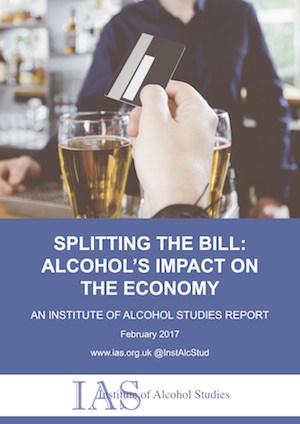 Cutting alcohol duty less beneficial to UK economy than industry claims, report says
Cutting alcohol duty less beneficial to UK economy than industry claims, report says
Industry claims of alcohol’s economic benefits to the UK have been overstated, claims a new report from the Institute of Alcohol Studies.
‘Splitting the Bill: Alcohol’s Impact on the UK Economy’ challenges the assertion often made by representatives of major alcohol business lobby groups that economic growth in the sector is hampered by legislative measures aimed at reducing alcohol-related health and social harms, therefore undermining the case for cutting duty in next month’s Budget.
The headline findings were:
- Any reduction in employment and income resulting from lower spending on alcohol would be offset by spending on other goods
- Econometric analysis of US states suggests that a 10% decrease in alcohol consumption is associated with a 0.4% increase in per capita income growth
- Lower alcohol consumption could also reduce the economic costs of impaired workplace productivity, alcohol-related sickness, unemployment and premature death, which are estimated to cost the UK £8-11 billion a year
The IAS analysis comes as health groups urge chancellor Philip Hammond to raise alcohol duty in his first Budget. Alcohol is 60% more affordable than it was in 1980. The Alcohol Health Alliance has called for higher tax on high strength ciders and the reintroduction of the alcohol duty escalator, which ensured above-inflation rises in alcohol tax levels every year between 2008 and 2013. Restarting the measure would help reverse real terms’ cuts to alcohol duty in the last four Budgets, estimated to cost the Exchequer £2.9 billion.
Public Health England also recently identified raising duty as one of the most cost-effective ways to reduce alcohol-related harm. The University of Sheffield calculated that an additional 6,500 people would be hospitalised each year as a result of the alcohol duty cuts in 2015.
The report’s author, Aveek Bhattacharya, Policy Analyst at the Institute of Alcohol Studies said:
“Economic arguments are regularly used to resist policies that tackle excessive alcohol consumption, such as raising duty. Yet raising the price of alcohol is more likely to benefit the economy than harm it, by reducing the productivity costs associated with workers’ harmful alcohol consumption.
“Cuts to alcohol duty impose a heavy toll on our health service and our public finances, with no clear corresponding benefit to the economy. The Government should reverse course, and undo the damage of four successive years of falling tax on alcohol duty.”
For a short video summary of the issues around alcohol pricing, please visit the IAS Vimeo page: https://vimeo.com/191959217
Signs of upward trend in alcohol-related mortality figures
Public health bodies express concern over rises since 2012
Official annual data published from two government departments estimate a rise in the number of alcohol-related deaths in the UK for the third year running, sparking fears among health campaigners that the nation’s relationship with alcohol may be getting worse.
According to the Office for National Statistics (ONS) ‘Alcohol-related deaths in the UK: registered in 2015’, there were 8,758 alcohol-related deaths in the UK in 2015, a slight increase on the previous year (8,697), and the third year in a row that the number of deaths had risen. It was also almost double the number of alcohol-related deaths than 20 years ago; in 1995, there were 4,929 alcohol-related deaths recorded in the UK.
Public Health England (PHE), which released its own estimates for England alongside the ONS using a different methodology, also found an increase in the number of alcohol-related deaths. According to its Local Alcohol Profiles for England (LAPE) report, there were approximately 23,500 alcohol-related deaths in England in 2015, roughly 500 more deaths than in 2014.
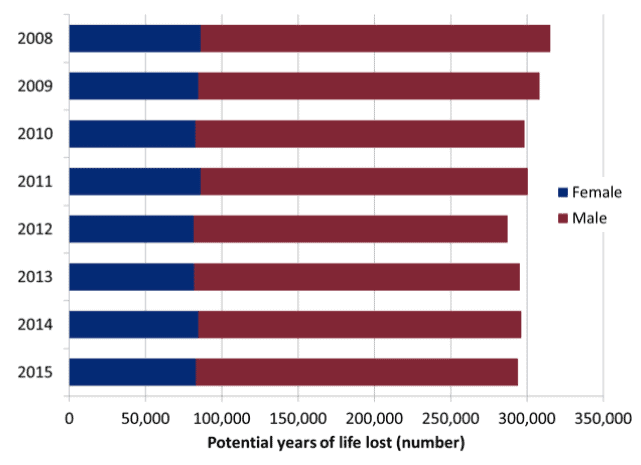 A mixed outlook
A mixed outlook
The ONS report commentary observed how rates of alcohol-related deaths remained stable in recent years, “with no statistical differences in the all person rate since 2012”, when the age-standardised mortality rate for alcohol-related deaths was 14.0 deaths per 100,000 population. In 2015, it was 14.2 deaths per 100,000 pop., up on 2012, but down on 2014 (-0.1).
The report also noted how there were slight improvements in alcohol-related mortality rates in England, as well as among males in general (especially in Scotland, which has seen the largest decrease in its rates since they peaked in the early 2000s). However, there were increases compared with 2014 for Welsh, Scottish and Northern Irish women (albeit not statistically significant). Among both sexes, alcohol-related death rates were highest in those aged 55 to 64 years. Alcohol-related mortality rates remain higher today for all 4 UK constituent countries than there were 20 years ago.
The PHE LAPE report found a slight increase in alcohol-related mortality rates alongside the raw numbers; in England, the rate of alcohol-related mortality rose slightly to 46.1 per 100,000 population in 2015 from 45.5 in 2014.
The LAPE report also introduced a new indicator measuring the potential years of life lost due to an alcohol-related cause, revealing that 294,000 years of life were lost before the age of 75 years in 2015 (illustrated).
Redefining alcohol-related deaths
The increasing use of LAPE data to capture the wider burden of alcohol consumption by public health groups has prompted the ONS to investigate the possibility of revising its own methodology.
LAPE data includes both deaths that are specifically caused by alcohol and deaths that are related to alcohol (such as strokes and certain cancers), whereas the ONS measure was developed for the purposes of monitoring alcohol-related deaths across all the constituent countries of the UK, using consistent methodology based solely on the information collected at death registration. The ONS measure is closer to PHE’s alcohol-specific mortality definition but is not identical.
The ONS is looking to redefine alcohol-related deaths, announcing that it will open a consultation on the matter sometime in the summer, with the aim of harmonising the consistency of outputs on deaths related to the abuse of alcohol produced by all government departments across the UK.
Drink driving casualties up, no progress on deaths
First rise in killed and seriously injured categories since 2011
The number of killed or seriously injured (KSI) drink-drive casualties is set to rise for the first time since 2011, according to new figures released by the Department for Transport (DfT).
The second provisional set of figures in the Reported road casualties in Great Britain, accidents involving illegal alcohol levels: 2015 report shows that the total number of drink-drive accidents rose by 2%, from 5,620 in 2014 to 5,740 in 2015. This means that around 4% of all reported road traffic accidents in 2015 involved at least one driver over the alcohol limit.
There was a 3% rise in overall drink-drive casualties from 8,210 in 2014 to 8,480 in 2015. The DfT revised down the central estimate of KSI drink-drive casualties that occurred over the period from 1,420 to 1,380. However this figure remains higher than in 2014 (1,310, see Chart 3, illustrated) and is “statistically significant”. The DfT report states that “if it holds to be correct when the final estimates are released in August 2017, it will be the first rise in drink-drive casualties since 2011.
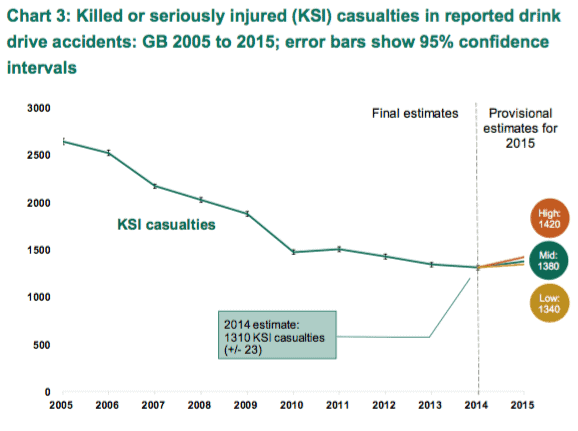 Anti drink-drive policy progress stalls
Anti drink-drive policy progress stalls
While these figures are provisional and may be revised, they concern road safety and health campaigners including Campaign Against Drink Driving and the Alcohol Health Alliance, who have called on the Government to lower the drink-drive limit in England and Wales in order to save lives and prevent serious injuries.
The report also adds to statistics showing that only around 40% of people killed or seriously injured by drink driving are drivers over the limit. Around 60% are other passengers, road users or pedestrians.
England and Wales currently have a high drink driving limit by international standards, set at 80mg alcohol/100ml blood. In December 2014, Scotland used its devolved powers to lower its limit to 50mg, and saw a 12.5% decrease in drink-drive offences in the first nine months of the new limit. The Northern Ireland Assembly is also in the process of lowering its drink driving limit too.
Despite other nations moving to fall in line with most European Union countries, the Department of Transport have refused to consider lowering the drink driving limit, a move supported by 77% of the public and a wide range of high profile groups, including the Police Federation, the College of Paramedics, the Fire Brigades Union, road safety charities, insurance firms and health bodies.
Jon Foster, senior research and policy officer at the Institute of Alcohol Studies, commented:
“It is worrying to see this increase in drink driving incidents and casualties, along with the fact that there has still been no progress in reducing drink driving deaths since 2010.
“The government have taken their eye off the ball, and need to listen to the overwhelming evidence that a lower drink driving limit would save lives and improve road safety. There is huge professional and public support for this.”
Alcolocks to reduce deaths on Europe’s roads
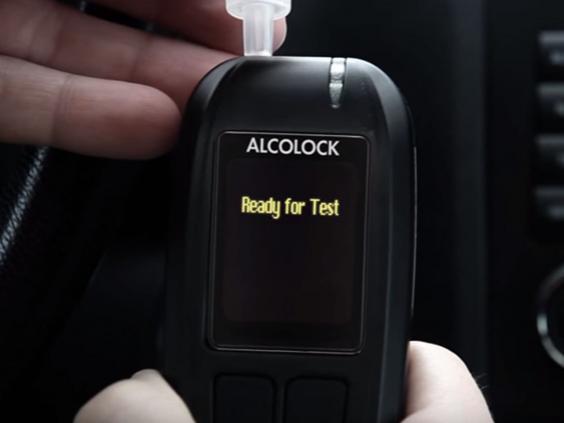 Move initiated by advisory body is welcomed by road safety group in UK
Move initiated by advisory body is welcomed by road safety group in UK
The EU could be poised to back the introduction of a radical new measure to prevent drivers starting their car engine while drunk, in a bid to reduce alcohol-related deaths on Europe’s roads.
So-called alcolocks have received backing from an influential group inside Brussels, with the European Parliament and the Council of the European Union both also said to be supportive of strict new alcohol rules.
The roll-out of alcolocks is being pushed as part of recommendations for the EU to establish a new alcohol strategy and to improve labelling, increase efforts to protect children and target binge-drinking. If adopted, the measure would most likely be applied to public transport, including school buses, as well as heavy goods vehicles.
The EU is being urged to legislate for their wide-scale use by the European Committee of the Regions (CoR), an advisory body made up of local and regional politicians that has a consultative role in EU policymaking.
CoR says the use of alcolocks should be encouraged “to bring down the number of deaths on Europe’s roads”.
A document released by CoR claims that the measure has the backing of the Council of the European Union and the European Parliament.
The Council of the European Union will debate road safety at a high-level conference in Malta on 28 March, and it has been rumoured that the roll out of alcolocks would be one of the topics discussed, raising the prospect that the measure could make its way into official Brussels policy, according to The Independent.
The Council is reported to have said that it had not yet cast a judgement on the use of alcolocks, but a recent document released by the group – which comprises government ministers from each EU country – lists reducing alcohol deaths on Europe’s roads as one of its priorities.
Department for Transport statistics show around 14% of all deaths in road accidents involved a driver over the drink-drive limit.
Alcolocks – another weapon in the battle against drink driving
Alcolocks, or alcohol interlock systems, are automatic systems that require the driver to blow into a breathalyser fitted inside their car. They can be adjusted to kick in at different limits but generally mean the vehicle can only be started if no alcohol is detected.
The device is increasingly used across several European countries, as a preventative measure against drink-driving in both personal and professional capacities.
Alcolocks are already fitted on National Express coaches operating in Britain, after the company installed the device on more than 500 of its vehicles for a two-year trial period. It followed the jailing of a National Express driver in 2008, who was found to be over the legal drink-drive limit after his coach crashed and overturned on the M1.
Road safety charity IAM RoadSmart has backed calls for the introduction of alcolocks in the UK. Director of policy and research Neil Greig said the group would “welcome a large scale trial of alcolocks as a sentencing option for individuals with particular drink related problems”.
The European Transport Safety Council – a non-governmental organisation – has also supported the use of alcolocks. Finland already enjoys strict rules on alcohol and driving, where it is compulsory to test all road users involved in a fatal crash for alcohol.
Pilot schemes have been run across Europe, from the Netherlands to Slovenia, with voluntary use of alcolocks in commercial vehicles seen on parts of the continent.
Austria and Ireland are also considering fitting alcolocks to the cars of motorists who are repeatedly caught drink driving.
Drink cycling “much more acceptable” than drink driving
Study looks into the differing attitudes towards drinking alcohol and cycling, and drinking and driving
An online study published in the Accident Analysis and Prevention journal has found that drinking alcohol and then cycling is more socially acceptable than drinking alcohol and then driving a motor vehicle.
Psychologists from Dresden Technical University polled 267 people over their attitudes towards drink cycling and drink driving between November 2014 and February 2015. Far fewer respondents (n=15) said that they would not drink before cycling, compared with 74 who said that they would not do so before taking to the wheel of a car.
Cycling under the influence of alcohol was seen as less of a danger to oneself and to others than drink driving. “In all aspects covered, drink cycling was seen as more acceptable and less dangerous than drink driving,” said the researchers.
The study also found that those who witnessed drink cycling among their friends were more likely to do it themselves. “Persons who cycle more often under the influence observe drink cycling more often among their friends. They think they are less of a danger to themselves and others when cycling after alcohol consumption, and they agree less with the statement that one should leave one’s bike parked after alcohol consumption.”
The report follows a new law amendment in Slovakia making it possible to ride a bicycle with a blood alcohol concentration of 0.24 milligrammes per litres of blood, an exception to their zero tolerance blood / alcohol limit. In Germany, the legal blood alcohol limit for cycling is also higher than that for driving.
In Britain, there is no specified blood alcohol limit for those cycling, although it is illegal to cycle ‘under the influence’ of alcohol or drugs to the extent where you are ‘incapable of having proper control of the cycle’, leaving the law open to interpretation, says Cycling Weekly.
APPG on Children of Alcoholics launches manifesto
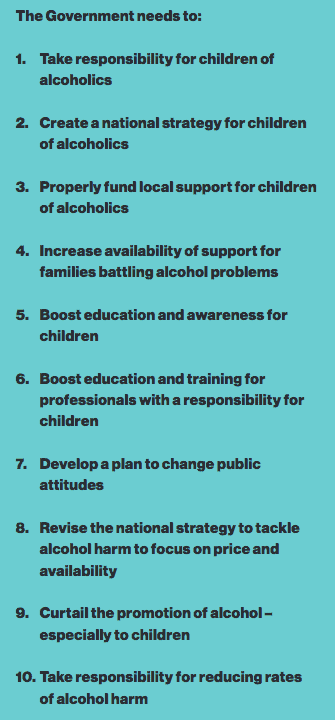 10-point plan to tackle “Britain’s biggest secret scandal”
10-point plan to tackle “Britain’s biggest secret scandal”
The All Parliamentary Party Group for Children of Alcoholics launched its manifesto as part of Children of Alcoholics Week 2017.
Hosted by the National Association of Children of Alcoholics (NACOA) at Portcullis House in Westminster, the event involved speeches from Labour MPs Liam Byrne and Caroline Flint, as well as the unveiling of a 10-point plan designed to break the silence around what the manifesto describes as “Britain’s biggest secret scandal”.
The launch followed a parliamentary debate on Tackling Alcohol Harm held earlier in the month where Jon Ashworth MP revealed he was the child of an alcoholic to fellow MPs.
10 demands for government action
The report ‘A manifesto for change’, which is supported by the Archbishop of Canterbury, finds an absence of strategies to deal with the issue and a lack of funding in many areas, contributing to serious failings in the care of an estimated 2.5 million children in the UK whose parents misuse alcohol.
The manifesto’s 10 demands for government action (pictured), include better education for children and professionals, better support or families and action on availability and promotion of alcohol.
Nicola Blackwood, the public health minister, promised to produce a new strategy to help the children of people with alcohol problems, after she was moved to tears hearing Jon Ashworth talk about his father’s drinking. She praised Ashworth – along with Byrne – for speaking out about their experiences of growing up with a parent with a drinking problem.
“I hope each member who has spoken today will continue to work with me as we fight to tackle this social injustice,” she said, promising to discuss drawing up a strategy for tackling the problem.
Wales: Heavy drinkers who die never access treatment services
Report calls for easily accessible, well-networked system of care to support sufferers
Thousands of high risk drinkers are dying without accessing alcohol treatment services, despite many of them making repeated admissions to hospitals, says a Public Health Wales report.
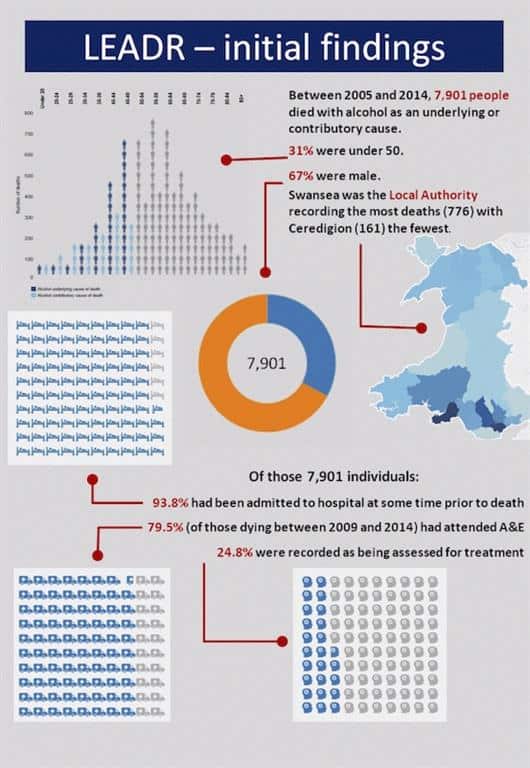 ‘The Linked Environment for Alcohol Death Research’ (LEADR) report links, for the first time, the health record of 7,901 individuals registered as dying from alcohol, either as an underlying or contributory factor, between 2005 and 2014.
‘The Linked Environment for Alcohol Death Research’ (LEADR) report links, for the first time, the health record of 7,901 individuals registered as dying from alcohol, either as an underlying or contributory factor, between 2005 and 2014.
It finds that an assessment for specialist substance misuse (alcohol or drug) treatment was recorded for only a quarter (24.8%) of drinkers prior to their death, despite most alcohol deaths being the result of many years of heavy and persistent consumption. This suggests that there may be a number of barriers to seeking help including the fear of being labelled or stigmatised.
Other key findings were:
- A third (31%) of the 7,901 alcohol-related deaths registered between 2005 and 2014 were among those aged under 50 years. The most frequently observed five-year age band at death (where the alcohol-related condition was listed as the underlying cause) was 55–59.
- 94% were recorded as having been previously admitted to hospital. Of this, there were 10 admissions per patient (on average), five of which were due to conditions related to alcohol consumption.
- The majority of the deaths attributed to alcohol from 2005 to 2014 were due to alcoholic liver disease (66%), with a further fifth down to fibrosis and cirrhosis of the liver.
- 9,755 individuals were admitted to hospital in 2005 with a condition related to alcohol consumption; of whom 15% (1,505) had died of an alcohol-related condition by 2015.
The LEADR project was developed by Public Health Wales to identify ways to reduce alcohol-related deaths in Wales, and identify opportunities for better access, engagement and treatment from physical and mental health services and specialist substance misuse services. Public Health Wales say the results from the study should urge people to recognise when their drinking may be starting to cause problems, and to act by seeking help earlier.
Josie Smith, Programme and National Lead for Substance Misuse at Public Health Wales, said: “We knew anecdotally, and now from the findings of this report, that not enough people are seeking help for their problems with alcohol. This may be due to a range of cultural and service barriers.
“We know that often people do not think they have a problem with alcohol because they do not need to drink every day or ‘to have a drink first thing in the morning’. However, we know that alcohol affects different people in different ways and that for some people, even regular heavy drinking will be enough to damage their health.
“In addition, people may feel that they do not want to seek support to reduce their drinking due to fear of being labelled an alcoholic, or thinking that they may have to stop drinking all together.
“The truth is, if alcohol is affecting your life in negative ways, then that is the time to get support and work to more positive patterns of drinking – the earlier the better.
“Anyone who needs support for drug or alcohol-related concerns can contact the Wales Drug and Alcohol Helpline on freephone 0808 808 2234, by texting DAN to: 81066 or by visiting dan247.org.uk.”
All services should “ensure an easily-accessible, timely and well networked system of care that can support a wide range of individuals and addresses barriers to seeking help”, the report concludes.
Podcast
Our monthly podcast features interviews with experts from across the sector.
Gambling industry harms and parallels with the alcohol world
Will Prochaska –
Coalition to End Gambling Ads

